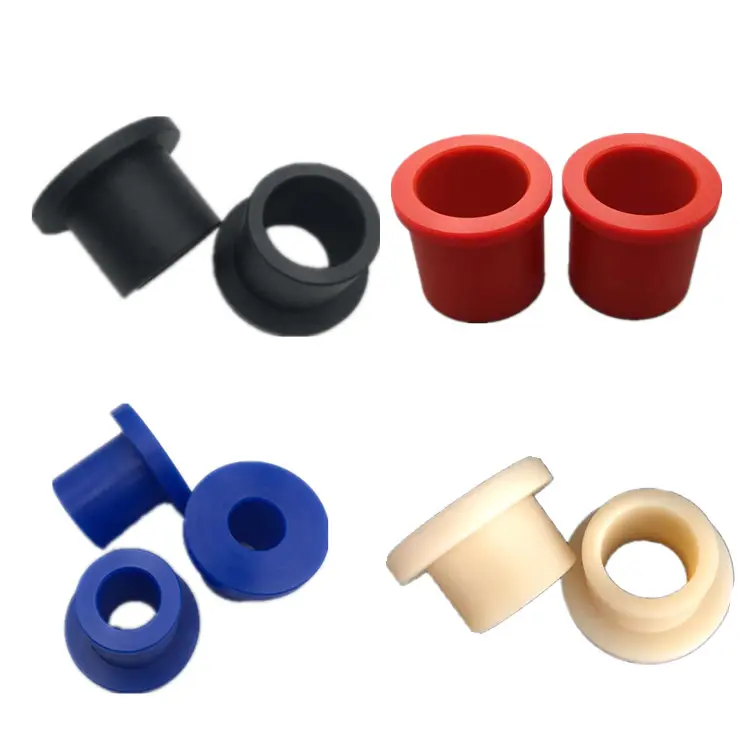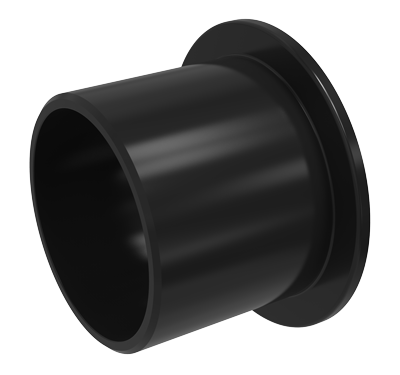Product Description
Plastic Sleeve Nylon Bush Polyurethane Bushing
|
Product Name: |
Plastic bushing |
|
Application : |
Domestic electrical, automotive ,engineering machinery ,industry ,etc |
|
Material: |
Nylon PA6, Nylon, ABS, POM,PTFE |
|
Color: |
Black/white/yellow or others |
|
Material Density: |
1.25~1.64g/cm3 |
|
Max PV value : |
0.27~1.40 N/mm²·m/s |
|
Tensile Strengthen: |
40~90MPa |
|
Hardness: |
72~90 HRR |
|
Thermal conductivity: |
0.24 W/(m·k) |
|
Friction: |
0.08~0.26 |
|
Working Temperature: |
-80~+240ºC |
|
In addition to the standard product catalog is displayed, we provide non-standard product or to order according to customer requirements. |
|
Packing & Delivery
Packing Details:
1. Inner Packing
For small products: 100pcs-200pcs per sealed plastic bag. For bigger products: 2pcs-10pcs per plastic film roller (depends on the product size)
2. Outer Packing&Shipment Packing
8pcs-300pcs per carton (depends on the product size)
18-24 cartons per wood case or pallet, shockproof and safe for transportation.
Company Profile
Our Factory
FAQ
Q: Are you trading company or manufacturer?
A: Our management is focused on exporting activities for more than 10 years and we have our own bushing factory. CHINAMFG is always professional and reliable. Our advantages are multiple resource integration, strong quality assurance and excellent service level. We are always responsible for our products
Q: Hong long is your delivery time?
A: Generally 10-25 days after order. It depends on the quantity.
Q: Do you produce samples? Is it free or extra?
A: For standard products, we produce samples free of charge for our customers. And the express costs will be burdened by the customer, but can be returned after the order is placed.
Q: How to ensure the quality?
A: We produce as per the confirmed technology or drawings for each order for our customers. And our factory has a strict quality control system. We inspect goods during production according to a certain frequency and we also perform the final inspection before the goods are packed.
Q: Do you like to serve the customers only with small orders?
A: We are always glad to grow up together with all our customers whatever big or small.
We hope our customers become stronger and stronger to be with us.
/* January 22, 2571 19:08:37 */!function(){function s(e,r){var a,o={};try{e&&e.split(“,”).forEach(function(e,t){e&&(a=e.match(/(.*?):(.*)$/))&&1
| Customized: | Customized |
|---|---|
| Certification: | ISO |
| Universal: | Yes |
| Customization: |
Available
| Customized Request |
|---|
.shipping-cost-tm .tm-status-off{background: none;padding:0;color: #1470cc}
| Shipping Cost:
Estimated freight per unit. |
about shipping cost and estimated delivery time. |
|---|
| Payment Method: |
|
|---|---|
|
Initial Payment Full Payment |
| Currency: | US$ |
|---|
| Return&refunds: | You can apply for a refund up to 30 days after receipt of the products. |
|---|
Are there specific guidelines for recycling or disposing of nylon bushings at the end of their life cycle?
Yes, there are specific guidelines for recycling or disposing of nylon bushings at the end of their life cycle. Here are some considerations:
1. Recycling:
– Nylon bushings, being made of a thermoplastic material, are generally recyclable. However, the specific recycling guidelines may vary depending on the composition of the nylon and the recycling facilities available in your area.
– Check with local recycling centers or waste management authorities to determine if they accept nylon bushings for recycling. They can provide information on the collection methods, sorting requirements, and any specific instructions for preparing the bushings for recycling.
– It’s important to separate nylon bushings from other materials and ensure they are clean and free of contaminants before recycling. Removing any metal inserts or other components attached to the bushings can facilitate the recycling process.
2. Specialty Recycling Programs:
– In some cases, there may be specialty recycling programs or initiatives specifically designed for industrial components like nylon bushings. These programs focus on recycling materials that are commonly used in industrial applications and may offer specialized recycling processes.
– Research and inquire about any such programs available in your region or industry. These programs may have specific collection points or partnerships with recycling facilities that can handle nylon bushings effectively.
3. Manufacturer Take-Back Programs:
– Some manufacturers or suppliers of nylon bushings may have take-back programs in place. These programs allow customers to return their used bushings to the manufacturer or supplier for proper recycling or disposal.
– Contact the manufacturer or supplier of the nylon bushings and inquire about any take-back programs they offer. They can provide guidance on the process, collection points, or specific instructions for returning the bushings.
4. Local Regulations and Guidelines:
– Be aware of any local regulations or guidelines regarding the disposal of nylon bushings. Different regions may have specific requirements or restrictions on the disposal methods for certain types of materials.
– Check with local environmental agencies or waste management authorities to understand the regulations in your area. They can provide information on proper disposal methods, landfill restrictions, or any hazardous waste classification that may apply to nylon bushings.
5. Reuse or Repurpose:
– Instead of recycling or disposing of nylon bushings, consider exploring opportunities for reuse or repurposing. Depending on their condition and functionality, nylon bushings can potentially be used in other applications or donated to organizations that can utilize them.
– Connect with local community organizations, educational institutions, or makerspaces that may have a need for industrial components like nylon bushings. They may accept donations or provide guidance on how to repurpose the bushings effectively.
It’s important to follow the guidelines and regulations in your specific region when recycling or disposing of nylon bushings. By doing so, you can ensure proper waste management, minimize environmental impact, and contribute to sustainability efforts.
Where can I find video tutorials on the proper installation and maintenance of nylon bushings in machinery?
If you are looking for video tutorials on the proper installation and maintenance of nylon bushings in machinery, here’s a detailed explanation:
1. Online Video Platforms:
– Platforms such as YouTube, Vimeo, and Dailymotion host a vast collection of video tutorials on various topics, including installation and maintenance procedures for mechanical components like nylon bushings.
– Use the search function on these platforms and enter relevant keywords such as “nylon bushing installation” or “nylon bushing maintenance” to find specific video tutorials on the topic.
– Look for videos created by reputable sources, such as manufacturers, industry experts, or professional organizations, to ensure the accuracy and reliability of the information provided.
2. Manufacturer Websites:
– Visit the websites of manufacturers that produce nylon bushings. Many manufacturers provide educational resources, including video tutorials, to guide users on the proper installation and maintenance of their products.
– Go to the “Resources,” “Support,” or “Technical Documentation” sections of the manufacturer’s website, where you may find video tutorials specifically focused on nylon bushing installation and maintenance.
– Some manufacturers also create dedicated YouTube channels or video libraries within their websites, making it easier to access the instructional videos related to nylon bushings.
3. Industrial Training Websites:
– Online platforms that offer industrial training and educational content often include video tutorials on various mechanical components and maintenance procedures, including nylon bushings.
– Explore websites that specialize in industrial training, maintenance skills, or machinery operation. These platforms may have video courses or tutorials that cover the installation and maintenance of nylon bushings.
– Look for video tutorials specifically related to machinery maintenance, bearing installation, or bushing replacement, as they are likely to include guidance on nylon bushings as well.
4. Mechanical Engineering Forums and Communities:
– Participate in mechanical engineering forums or online communities where professionals and enthusiasts discuss machinery maintenance and related topics.
– Post inquiries or search within these forums for video tutorials on nylon bushing installation and maintenance. Members of the community may share their own video tutorials or recommend reliable sources.
– Be an active participant in these forums, as members often share valuable resources and insights based on their experiences.
5. Professional Associations and Trade Shows:
– Explore websites or official channels of professional associations and trade organizations related to mechanical engineering or specific industries where nylon bushings are commonly used.
– Check if these organizations host video tutorials or webinars on machinery maintenance or component installation. They may cover topics such as nylon bushing selection, installation techniques, and maintenance best practices.
– Attend trade shows, conferences, or seminars where experts in the field present video demonstrations or provide hands-on training on the installation and maintenance of mechanical components.
By utilizing online video platforms, manufacturer websites, industrial training platforms, mechanical engineering forums, professional associations, and trade shows, you can find a wide range of video tutorials on the proper installation and maintenance of nylon bushings in machinery. These tutorials can provide visual guidance and step-by-step instructions to help you ensure the correct handling and care of nylon bushings in your specific applications.
What are the advantages of using nylon bushings over other materials in mechanical applications?
When it comes to mechanical applications, using nylon bushings offers several advantages over other materials. Here’s a detailed explanation:
1. Self-Lubricating Properties:
– Nylon bushings have inherent self-lubricating properties, which reduce the need for additional lubrication. The low friction coefficient of nylon helps in smooth and efficient operation, reducing wear and extending the lifespan of the bushing and the mating parts.
– Self-lubricating nylon bushings are particularly beneficial in applications where frequent maintenance or lubrication is impractical or challenging, such as in hard-to-reach areas or in environments with limited access.
2. Excellent Wear Resistance:
– Nylon bushings have excellent wear resistance, making them suitable for applications with high loads or repetitive motion. They can withstand continuous contact and friction without significant wear or degradation.
– The inherent toughness and durability of nylon make it resistant to abrasion, allowing the bushings to maintain their performance and dimensional stability over time.
3. Low Coefficient of Friction:
– Nylon bushings have a low coefficient of friction, which minimizes the resistance to motion. This low friction characteristic helps reduce energy consumption, minimize heat generation, and improve operational efficiency.
– The low friction coefficient of nylon bushings also contributes to smoother and quieter operation, reducing noise and vibration in mechanical systems.
4. Corrosion Resistance:
– Nylon is inherently resistant to corrosion from moisture, chemicals, and most industrial environments. This corrosion resistance makes nylon bushings suitable for applications where exposure to harsh conditions or corrosive substances is a concern.
– Unlike metal bushings that may require additional protective coatings or regular maintenance to prevent corrosion, nylon bushings can withstand corrosive environments without compromising their performance.
5. Lightweight and Cost-Effective:
– Nylon is a lightweight material, which can contribute to overall weight reduction in mechanical systems. This is particularly advantageous in applications where weight is a critical factor, such as aerospace or automotive industries.
– Nylon bushings are often cost-effective compared to other materials, such as bronze or stainless steel. They offer a balance of performance and affordability, making them a cost-efficient choice for various mechanical applications.
6. Electrical Insulation:
– Nylon is an excellent electrical insulator, providing insulation and preventing electrical current flow between mechanical components. This property is beneficial in applications where electrical conductivity needs to be minimized, ensuring safety and preventing electrical interference.
– Nylon bushings can help isolate and protect electrical systems or components in machinery, reducing the risk of electrical shorts, arcing, or damage.
By leveraging the self-lubricating properties, excellent wear resistance, low coefficient of friction, corrosion resistance, lightweight nature, cost-effectiveness, and electrical insulation properties of nylon bushings, mechanical applications can benefit from improved performance, reduced maintenance requirements, and extended operational lifespan.
editor by CX 2024-03-26




